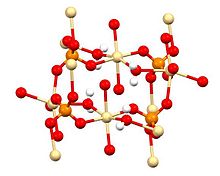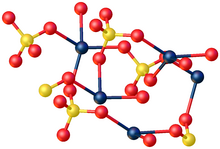Cadmium sulfate

| |
| Names | |
|---|---|
| IUPAC name
Cadmium(II) sulfate
| |
| Other names
Sulfuric acid, cadmium salt (1:1),
| |
| Identifiers | |
| |
3D model (
JSmol ) |
|
| ChEBI |
|
| ChemSpider | |
ECHA InfoCard
|
100.030.288 |
| EC Number |
|
| 8295 | |
PubChem CID
|
|
RTECS number
|
|
| UNII | |
| UN number | 2570 |
CompTox Dashboard (EPA)
|
|
| |
| |
| Properties | |
| CdSO4 CdSO4·H2O (monohydrate) 3CdSO4·8H2O (octahydrate) | |
| Molar mass | 208.47 g/mol (anhydrous) 226.490 g/mol (monohydrate) 769.546 g/mol (octahydrate) |
| Appearance | White hygroscopic solid
|
| Odor | odorless |
| Density | 4.691 g/cm3 (anhydrous) 3.79 g/cm3 (monohydrate) 3.08 g/cm3 (octahydrate)[1] |
| Melting point | 1,000 °C (1,830 °F; 1,270 K) (anhydrous) 105 °C (monohydrate) 40 °C (octahydrate) |
| Boiling point | (decomposes to basic sulfate and then oxide) |
| anhydrous: 75 g/100 mL (0 °C) 76.4 g/100 mL (25 °C) 58.4 g/100 mL (99 °C) monohydrate: 76.7 g/100 mL (25 °C) octahydrate: very soluble | |
| Solubility | slightly soluble in methanol, ethyl acetate insoluble in ethanol |
| -59.2·10−6 cm3/mol | |
Refractive index (nD)
|
1.565 |
| Structure | |
| orthorhombic (anhydrous) monoclinic (hepta & octahydrate) | |
| Thermochemistry | |
Std molar
entropy (S⦵298) |
123 J·mol−1·K−1[2] |
Std enthalpy of (ΔfH⦵298)formation |
−935 kJ·mol−1[2] |
| Hazards | |
| GHS labelling: | |
  
| |
| Danger | |
| H301, H330, H340, H350, H360, H372, H410 | |
| P201, P202, P260, P264, P270, P271, P273, P281, P284, P301+P310, P304+P340, P308+P313, P310, P314, P320, P321, P330, P391, P403+P233, P405, P501 | |
| NFPA 704 (fire diamond) | |
| Lethal dose or concentration (LD, LC): | |
LD50 (median dose)
|
280 mg/kg (oral, rat) |
| NIOSH (US health exposure limits): | |
PEL (Permissible)
|
[1910.1027] TWA 0.005 mg/m3 (as Cd)[3] |
REL (Recommended)
|
Ca[3] |
IDLH (Immediate danger) |
Ca [9 mg/m3 (as Cd)][3] |
| Safety data sheet (SDS) | [1] |
| Related compounds | |
Other anions
|
Cadmium acetate, Cadmium chloride, Cadmium nitrate |
Other cations
|
Zinc sulfate, Calcium sulfate, Magnesium sulfate |
Except where otherwise noted, data are given for materials in their standard state (at 25 °C [77 °F], 100 kPa).
| |
Cadmium sulfate is the name of a series of related inorganic compounds with the formula CdSO4·xH2O. The most common form is the monohydrate CdSO4·H2O, but two other forms are known CdSO4·8⁄3H2O and the anhydrous salt (CdSO4). All salts are colourless and highly soluble in water.
Structure, preparation, and occurrence

Cadmium sulfate hydrate can be prepared by the reaction of cadmium metal or its oxide or hydroxide with dilute sulfuric acid:
- CdO + H2SO4 → CdSO4 + H2O
- Cd + H2SO4 → CdSO4 + H2
The anhydrous material can be prepared using sodium persulfate:[citation needed]
- Cd + Na2S2O8 → CdSO4 + Na2SO4
Cadmium sulfates occur as the following rare minerals drobecite (CdSO4·4H2O), voudourisite (monohydrate), and lazaridisite (the 8/3-hydrate).
Applications
Cadmium sulfate is used widely for the electroplating of cadmium in electronic circuits. It is also a precursor to cadmium-based pigment such as
References
- ISBN 0-8493-0487-3.
- ^ ISBN 978-0-618-94690-7.
- ^ a b c NIOSH Pocket Guide to Chemical Hazards. "#0087". National Institute for Occupational Safety and Health (NIOSH).
- .
- PMID 26594423.

